If you have a backyard, bees probably come to mind. Especially if you garden. You might dream of having a nest of honeybees that will give you honey and pollinate your crops and plants. However, the honeybee is not native to any of the American continents. Instead, the animal poses a threat to the native bee populations. Plus, they are inefficient pollinators compared to their native cousins.
Instead, consider the Mason bee. The species is gentle and non-stinging and will help you grow the garden of your dreams, though you won’t get honey. To get started, here is everything you need to know about keeping backyard bees.
What are Mason Bees?
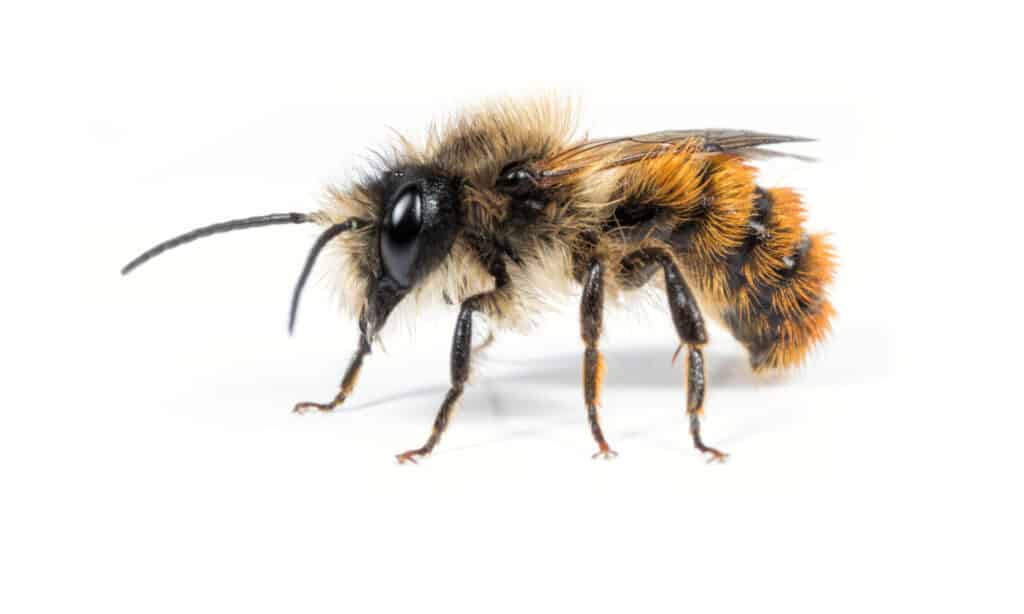
Mason bees are small and gentle.
©Ed Phillips/Shutterstock.com
Mason bees are solitary nesting bees that emerge in the early spring and lay eggs in skinny, tube-shaped cavities. They only sting if you trap, squeeze them, or threaten their nests. Across the northern hemisphere, and in Australia, there are about 300 species of Mason bees. Because they don’t make honey, little upkeep is required to successfully raise these fuzzy insects.
Because the animals are solitary, each one who lays cocoons is a Queen Bee. The individual will gather pollen and nectar, lay eggs, and maintain the mud nursery. Because of this busy life, the bees are not aggressive.
Mason bees emerge as adults in the early spring. Those that inseminate usually emerge before the nesters, and mating happens immediately. From there, the pregnant individuals will begin to lay eggs. They will provide a supply of food and seal the egg in a single cell with mud walls. The eggs hatch right away and begin to eat, grow, and pupate. The larva will spin a waterproof cocoon, which looks like a purple raisin, and overwinter. In the next spring, the adults will emerge and start the cycle again.
Why Gardeners Love Raising Mason Bees
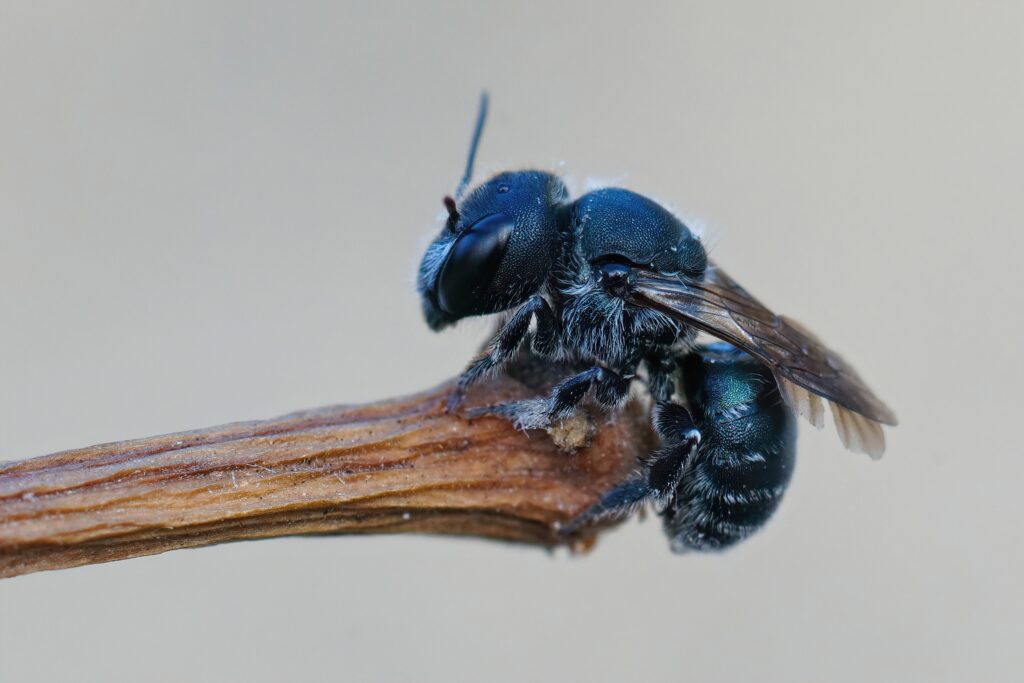
Mason bees come in a variety of colors.
©Wirestock Creators/Shutterstock.com
If you’re unsure and still think you might want honeybees instead, here are some reasons why professional and backyard gardeners prefer Mason bees.
- According to Bryan Danforth, Professor of Entomology at Cornell University, “[Mason Bees] are three times better pollinators than honeybees.“
- Mason bees stay within 300 feet of their home, while honeybees can go up to two miles from their hive. The longer distances makes them more likely to bring disease back.
- Mason bees are gentler than honeybees. The inseminating bees do not have stingers and those that raise larve will only sting when threatened.
- Raising Mason bees requires only a handful of hours each year, while honeybees require hours each week or even day.
- Gardeners do not need to wear protective gear around Mason bees.
- Mason bees are native to the American continent and work in harmony with the environment. Honeybees, on the other hand, are invasive and destroy future food supply chains by killing native bee populations.
Supplies You’ll Need
Cocoons
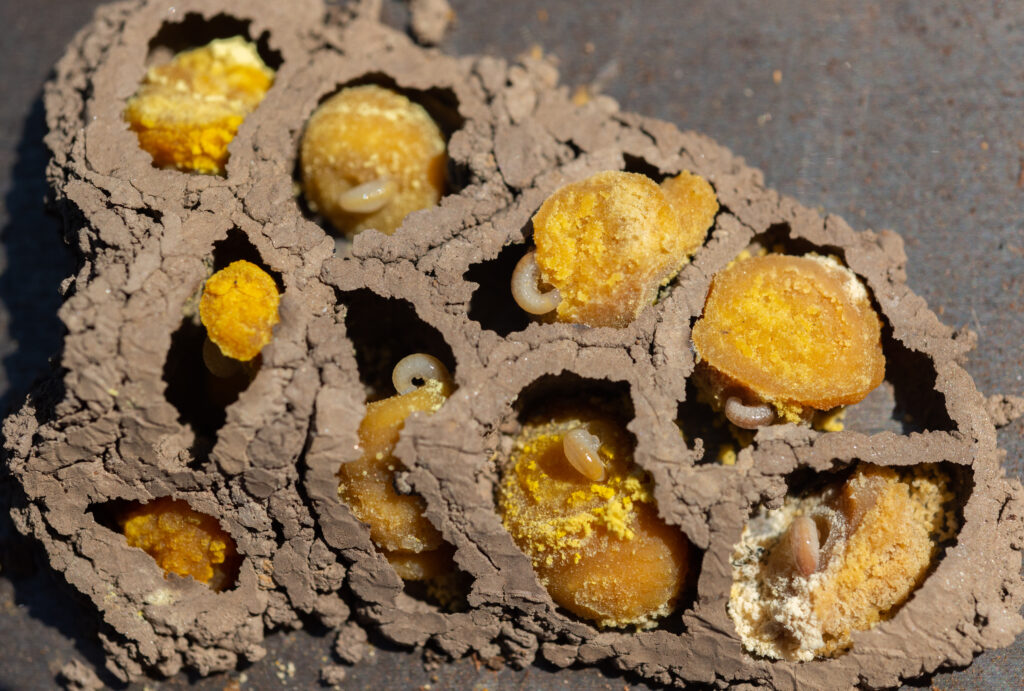
The name Mason comes from the animals’ use of mud to build walls of their larvae.
©Jennifer Bosvert/Shutterstock.com
Before you dive into the world of backyard bees, you’ll need to decide if you want to buy cocoons or attract animals native to your area. If you want to buy cocoons, be careful which seller you buy through. In the United States, there is no licensing or registration process for selling bees. Because of this, no one monitors what animal is actually inside the cocoon. And many of them can be quite expensive.
If you find a seller that is reputable and you trust, cocoons are a great way to kickstart your beekeeping. After allowing them to emerge in a mesh container, you can put them in their house and let them get a feel for the backyard. If you’d rather not buy cocoons, you don’t have to worry. Erect a house for local mason bees and they’ll slowly congregate. Because they are locally adapted, they’ll most likely be disease free.
Housing

Mason bees can get so overrun by mites that they cannot fly.
©Jaco Visser/Shutterstock.com
Mason bees have natural pests, parasites, and predators. You’ll want to focus on housing that helps them avoid these situations. Because natural nesting is far apart and random, bees that live in the wild are unlikely to spread pestilence among one another. This is especially true because mason bees are solitary nesters.
In artificial nesting, on the other hand, each individual bee lives next to the other. This makes the spread of diseases rapid and uncontrollable. In addition, nests in the wild are not often reused. Often, they rot, wash away, or are picked apart by birds. Because of this, the pathogens and parasites disappear as well. So, make sure to change the tubes of your mason bees every season to emulate this.
You’ll need a bee house lined with tubes or wood or bamboo to get started. You can either order one pre-built or build your own.
Mud, Garden, Fruit Trees
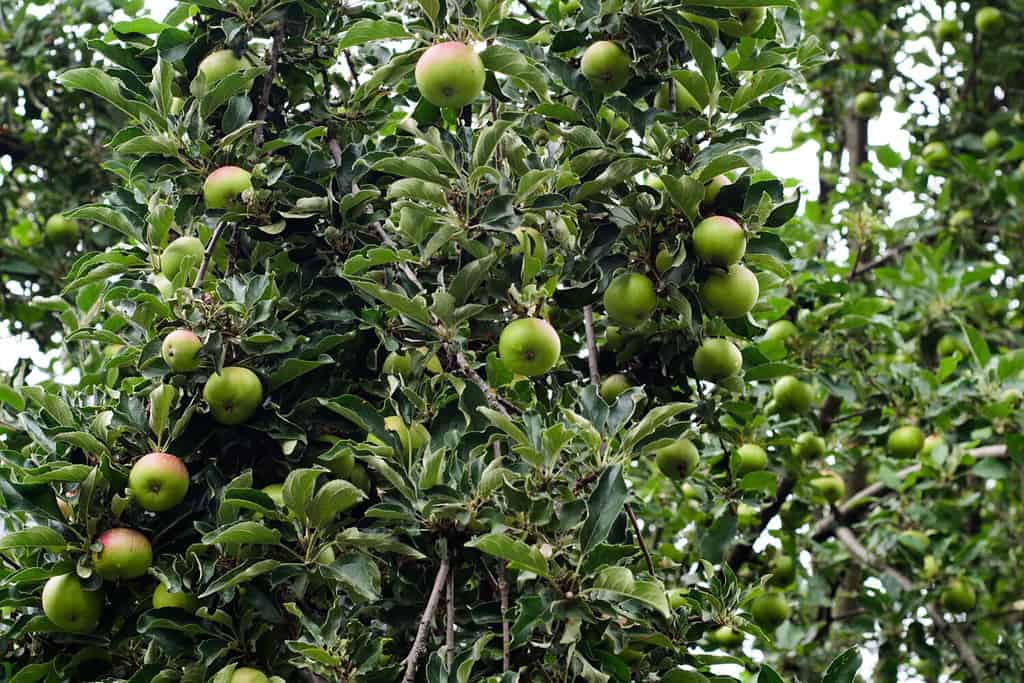
Mason bees love to pollinate any kind of fruit.
©AnastasiiaLee/Shutterstock.com
Mason bees use mud to help build their nest. If you want to start raising backyard bees, make sure to keep a steady supply of muddy ground for the animals to work with.
You’ll also want to supply the bees with a nearby garden or fruit trees. The animals do not discriminate with pollinating and will happily move into your artificial housing if they have plenty of food nearby.
How to Bring Mason Bees to Your Yard
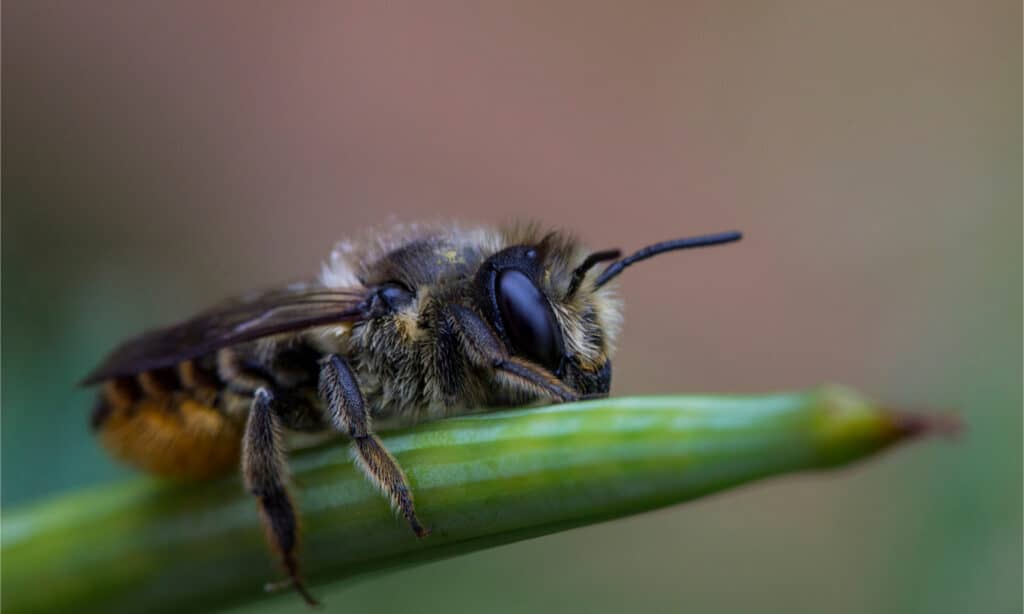
Mason bees are not picky with nesting sites.
©K R Bailey/Shutterstock.com
If you do not want to buy cocoons, you can still attract Mason bees if you live in an area native to them. You’ll want to place their house facing the morning sun, in a location that protects them from the wind and rain. Do not expect to get many Mason bees all at once. A few bees will stumble upon your home during the first year and the growth will happen from there.
You can also spray pheromones on your Mason bee home to attract more during the first year. Go easy on the spray though, you don’t want to completely fill your box right away. Give yourself time to ease into beekeeping and maintain a routine.
Problems with Raising Mason Bees

The
cocoons
can be eaten by wasps.
©M Huston/Shutterstock.com
Like all animals, mason bees can have issues. You might experience varroa mites, which feed on the pollen and nectar stored for the bee larvae. The bees then start to starve to death. Pollen mites build up over time, so make sure to regularly change housing tubes. You could also experience parasitic wasps, that will kill the bee larvae and adults to take over the tubes. Mason bees tend to live in the cavity for 10 months, so choose materials that avoid mold such as bamboo, paper straws, and hollow stems of lovage, elderberry, and teasel.
To avoid these issues, employ strategies that keep the housing fresh and clean. For example, use an emergence box every season to rotate the nesting tubes. Mason bees to not like to enter dark areas to find their nesting tubes. So, to change the tubes, put the old ones inside an emergence box with a single exit hole facing the sun. Then place the new nests within six feet of the box. The bees emerge, mate, and nest in the new tubes.
Some beekeepers scrub the cocoons with sand or soak them in bleach. Since this is not very natural, humans should avoid the practice. Regularly rotating the tubes and nesting blocks keeps parasites away.
Seasonal Guide
To start raising backyard bees, here is a seasonal breakdown.
Early Spring

Mason bees are one of the most common species of bee.
©HHelene/iStock via Getty Images
Put your Mason bee home in a sunny, protected location with water and clay-mud nearby. Arrange the tubes for the animals inside the house. Maybe sure that the local temperatures around reliably above 55 degrees Fahrenheit before you set up their housing. Your plants should be in the beginning stages of flowering so that the animals have a reliable food source.
Late Spring
Collect the nesting tubes and store them in your garage or shed. This protects them from harsh weather and parasites.
Fall
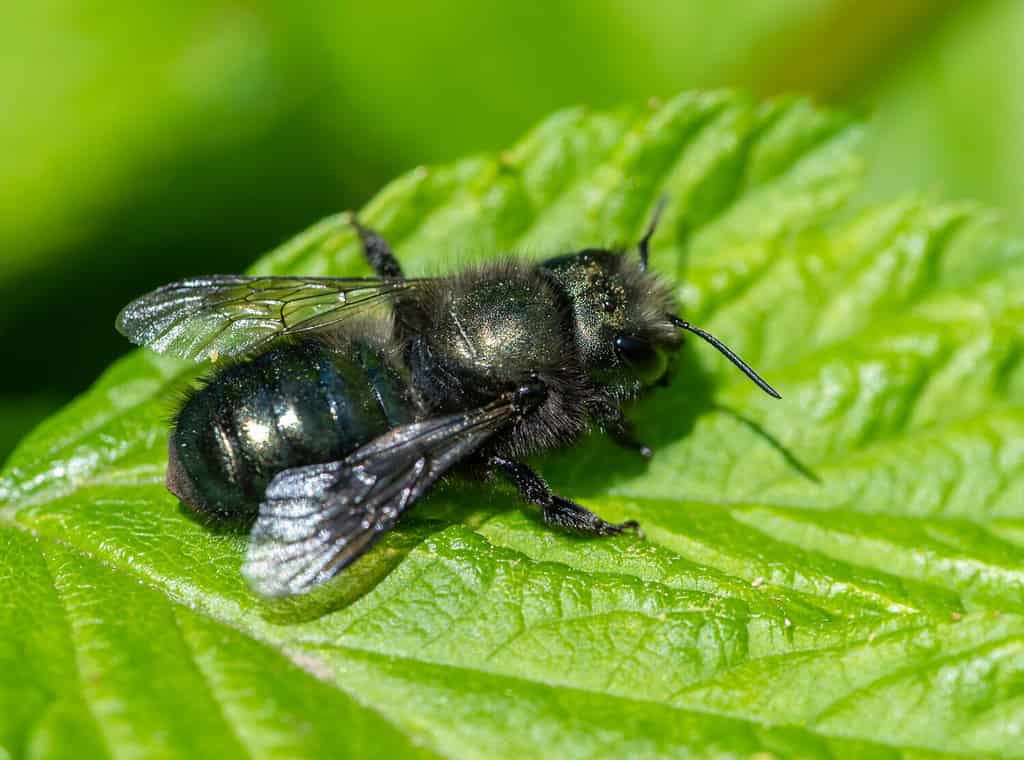
Humans can handle mason bees without issue, if they are gentle.
©Jennifer Bosvert/Shutterstock.com
Put the harvested bee cocoons in the fridge in a breathable box. The Mason bee cocoons thrive with a bit of humidity, so include a moist paper towel inside the box. Check the paper towel regularly and ensure it stays moist.
Winter
Share cocoons with family, friends, and other community members. Prepare the emergence box for the next spring.
The photo featured at the top of this post is © Wirestock Creators/Shutterstock.com
Thank you for reading! Have some feedback for us? Contact the AZ Animals editorial team.







